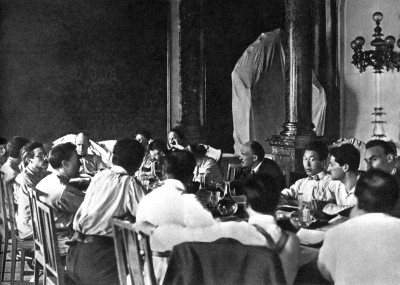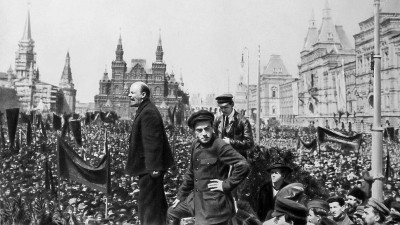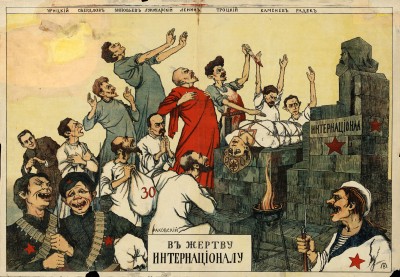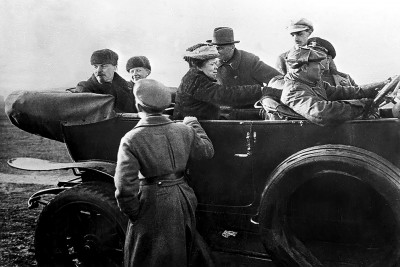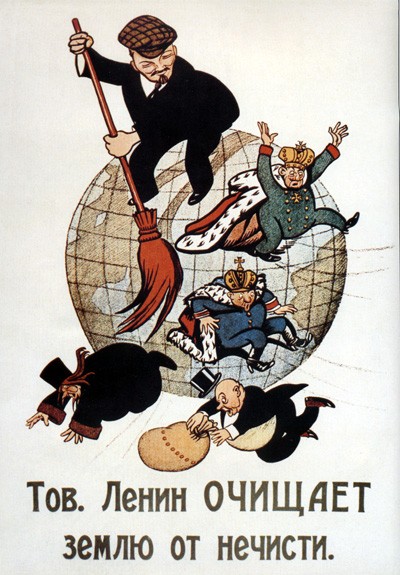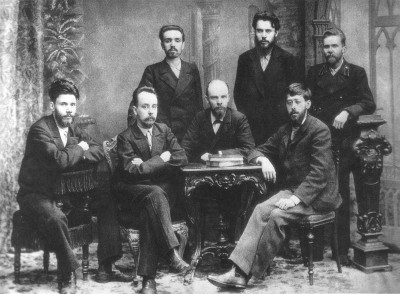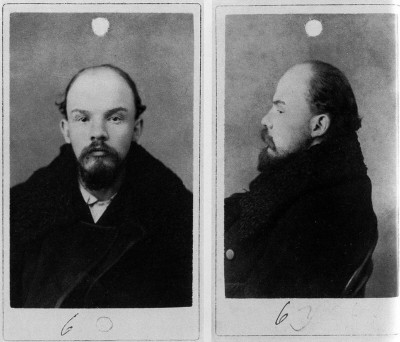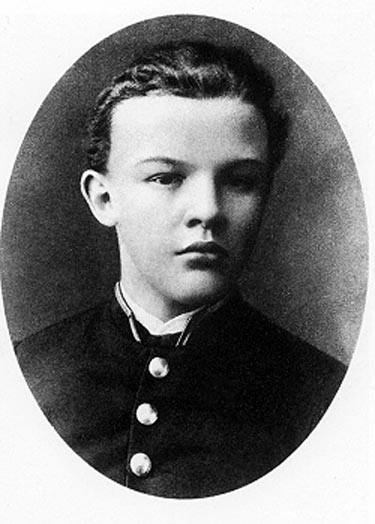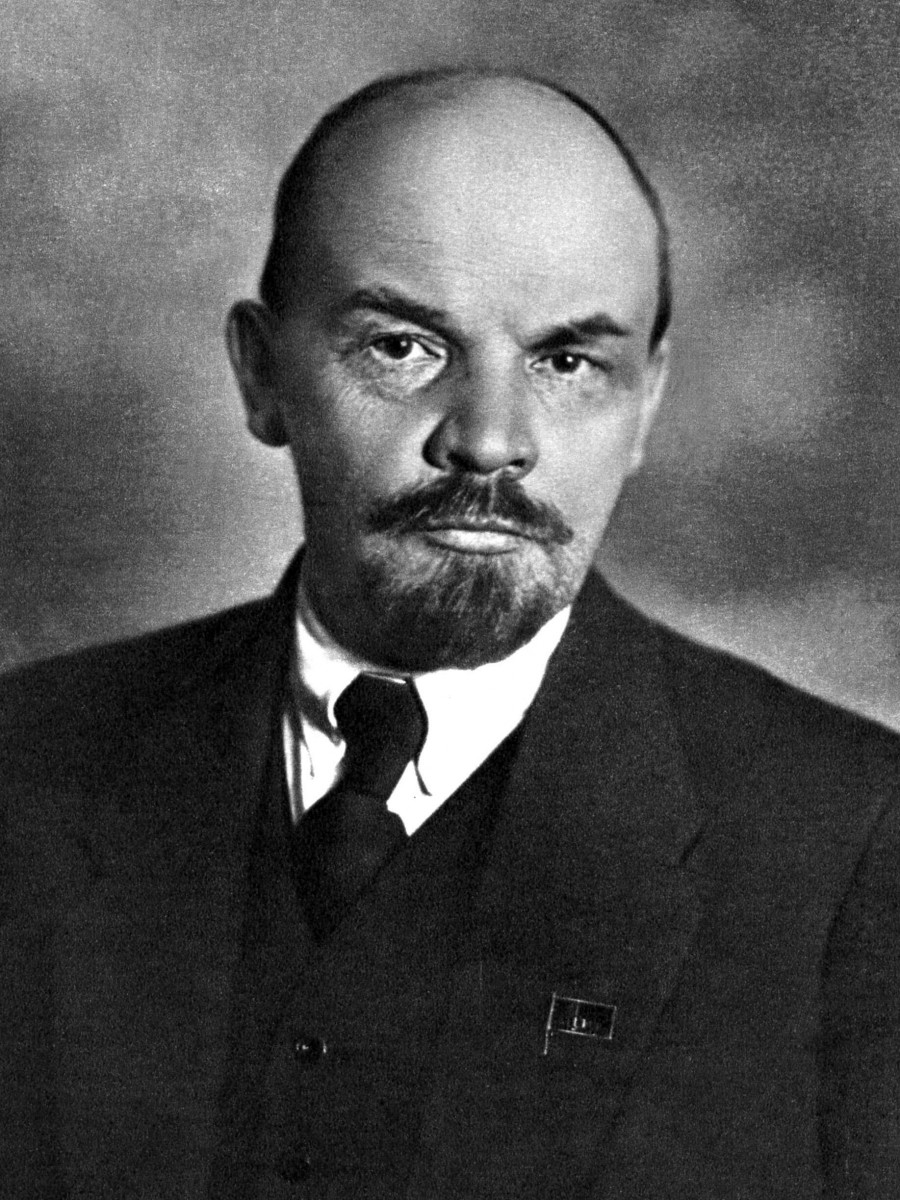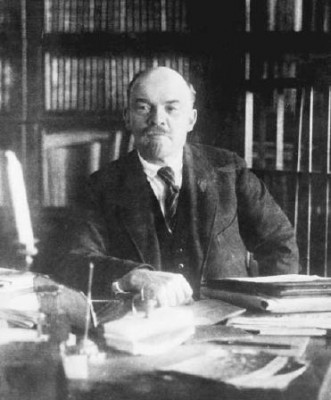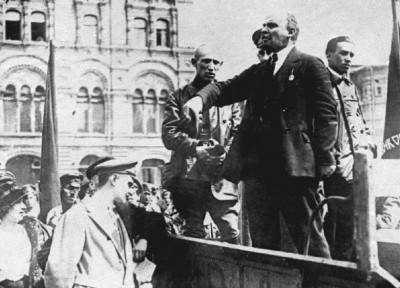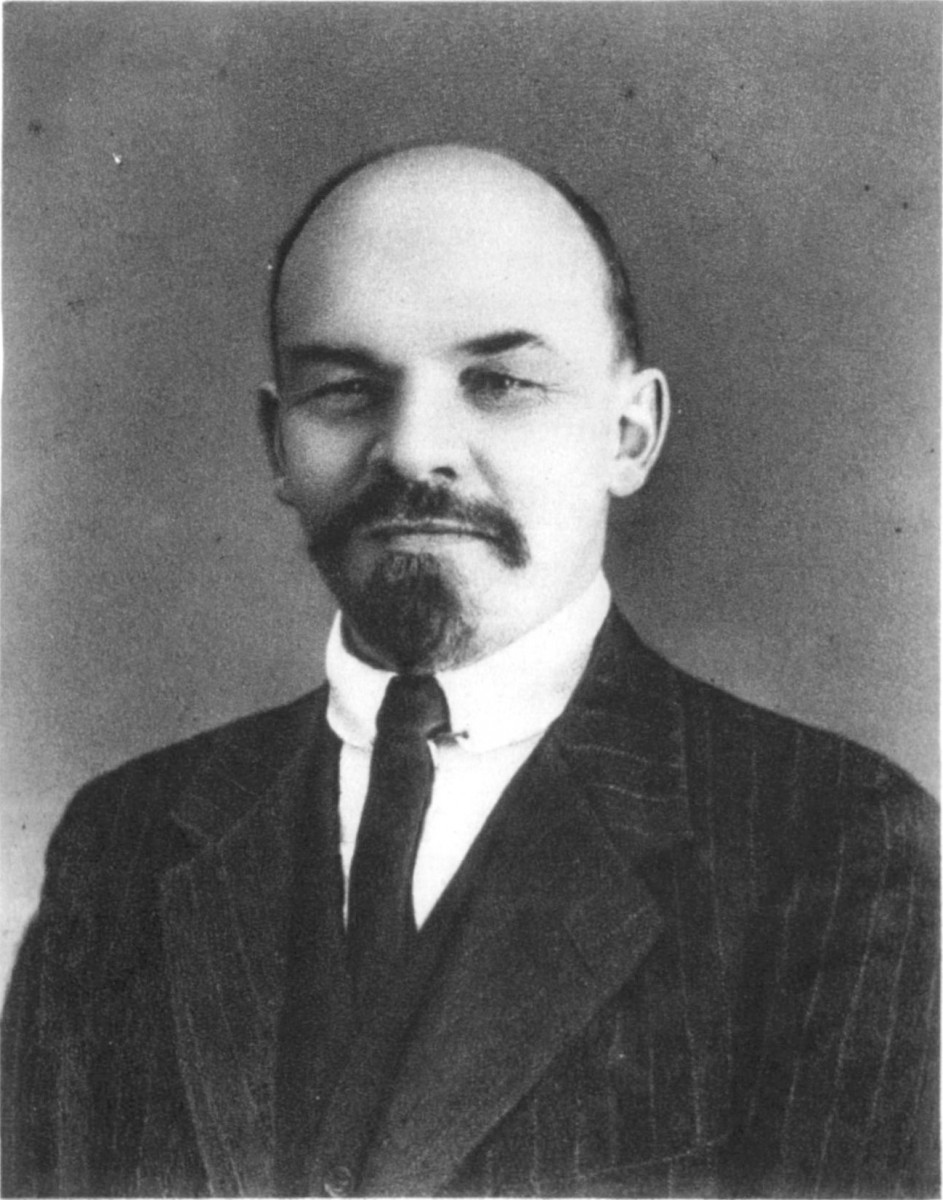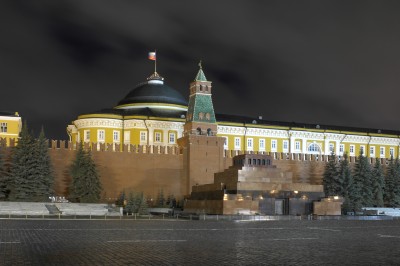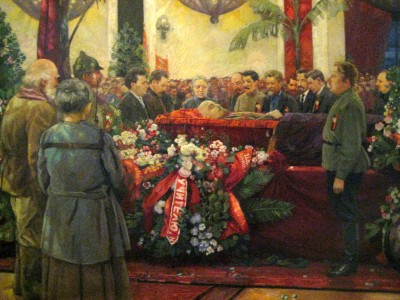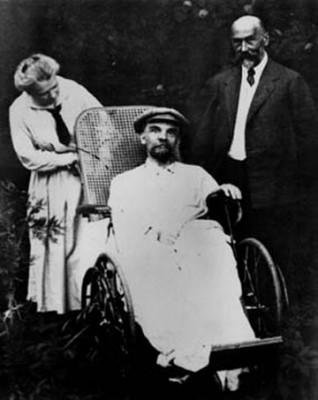| Příjmení: Surname: | Lenin | Lenin |
| Jméno: Given Name: | Vladimir Iljič | Vladimir Ilyich |
| Jméno v originále: Original Name: | Владимир Ильич Ленин | |
| Fotografie či obrázek: Photograph or Picture: | | |
| Hodnost: Rank: | - | - |
| Akademický či vědecký titul: Academic or Scientific Title: | - | - |
| Šlechtický titul: Hereditary Title: | - | - |
| Datum, místo narození: Date and Place of Birth: | 22.04.1870 Simbirsk | 22.04.1870 Simbirsk |
| Datum, místo úmrtí: Date and Place of Decease: | 21.01.1924 Gorki | 21.01.1924 Gorki |
| Nejvýznamnější funkce: (maximálně tři) Most Important Appointments: (up to three) | - předseda Rady lidových komisařů | - Chairman of the Council of People's Commissars |
| Jiné významné skutečnosti: (maximálně tři) Other Notable Facts: (up to three) | - rodné jméno: Vladimir Iljič Uljanov | - |
| Související články: Related Articles: | | |
| Zdroje: Sources: | http://en.wikipedia.org/wiki/Vladimir_Lenin cs.wikipedia.org | |
Lenin, Vladimir Iljič
| Příjmení: Surname: | Lenin | Lenin |
| Jméno: Given Name: | Vladimir Iljič | Vladimir Ilyich |
| Jméno v originále: Original Name: | Владимир Ильич Ленин | |
| Všeobecné vzdělání: General Education: | DD.MM.RRRR-DD.MM.RRRR | DD.MM.RRRR-DD.MM.RRRR |
| Vojenské vzdělání: Military Education: | DD.MM.RRRR-DD.MM.RRRR | DD.MM.RRRR-DD.MM.RRRR |
| Důstojnické hodnosti: Officer Ranks: | DD.MM.RRRR | DD.MM.RRRR |
| Průběh vojenské služby: Military Career: | | |
| Vyznamenání: Awards: | ||
| Poznámka: Note: | - | - |
| Zdroje: Sources: | http://en.wikipedia.org/wiki/Vladimir_Lenin cs.wikipedia.org | |
Born on April 22, 1870, in the Russian city of Simbirsk to a family of school inspectors. At the age of 23, as a law student, he became an ardent Marxist. In December 1895, the tsarist government had him arrested for revolutionary activities. He was imprisoned for 14 months and then sentenced to exile. During his 3-year stay in Siberia, he married N. K. Krupskaya and wrote his first writing - The Development of Capitalism in Russia. His exile ended in February 1900, and a few months later he left Russia for exile, where he spent 17 years working as a professional revolutionary. He edited the social-democratic journal Jiskra, around which he concentrated the majority (in Russian the majority) of SDDSR members. Then, at the party congress in London in 1903, he and his followers founded a radical revolutionary wing of the Social Democrats - the Bolshevik faction. His followers refused to build a mass workers' party and concentrated on creating a small organisation of professional revolutionaries. In 1912, at the Prague Congress of the SDDSR, he definitively broke with the Social Democrats, whom he accused of revisionism, and founded his own revolutionary party. He also began to publish a journal, Pravda, in which he propagated the theory of the gradual transformation of the democratic revolution into a socialist revolution, which he himself revised in April 1917.
After the outbreak of World War I, which he rejected as imperialist, he set out his thesis - to transform the war between the powers into a general civil war between the classes. In his writings Imperialism as the Highest Stage of Capitalism, however, he himself rethought (revised) Marxist doctrine by admitting that a socialist revolution could triumph in an underdeveloped country before it could triumph in the most industrialized countries of the world. By this country he meant Russia, which he called "the weakest link in the imperialist chain". As soon as Lenin learned of the Tsar's fall in February 1917 in his Swiss exile, he immediately returned to Russia via Germany and Sweden in a special sealed train. On his arrival in St. Petersburg, he urged the Bolsheviks to prepare for the imminent overthrow of the Provisional Government and the seizure of all power by the so-called Soviets. This was contrary to the majority opinion in the party, which had a majority in the soviets and expected to win the elections to the Constituent Assembly. However, Lenin, with the support of L. N. Trotsky, pushed his position on the necessity of a violent seizure of power, which he formulated in the so-called April Theses. After the failed coup in July, a warrant was issued for his arrest. Lenin fled to Finland, where he hid under a false name and with forged documents. There he wrote his seminal work The State and the Revolution, in which he described the method of seizing power and maintaining it. He replaced the Marxist thesis of the necessity of creating legitimate socio-economic conditions for the start of the revolution with his own theory of the creation of a "revolutionary situation" and its subsequent use for the forcible seizure of power by the parties of the revolutionary proletariat (Lenin at that time was still advocating cooperation with the peasant party of the left SS).
The second attempted coup in November 1917 succeeded and Lenin headed a coalition government of Bolsheviks and Left SS. He then had the elected Constituent Assembly, in which his government had only a minority of representatives, dissolved. He immediately brought into force the government decrees On Land and On Peace, which carried out land reform in favour of the landless and small peasants and concluded a separate peace with the Central Powers. In doing so, his government broke the Allied agreements and also aroused opposition among the middle peasants and bourgeoisie. In the course of the ensuing foreign intervention and civil war, Lenin brutally suppressed all opposition in the country (the "Red Terror") and established the so-called dictatorship of the proletariat. In July 1918, he broke with the left-wing SS and formed a one-party government. A month later, on 30 August, he was unsuccessfully assassinated by the SS terrorist Fanja Kaplan. The result was only an intensification of terror, the establishment of an all-powerful political police force - the Cheka - and concentration camps for the inconvenient. Lenin then banned factionalism within the Bolshevik Party to consolidate his personal authority. He was also behind the birth of the Communist International, whose purpose was to unleash a world revolution by force, directed from Moscow. Following the failure of the revolutions in Germany and Hungary and the collapse of agriculture, he proclaimed the so-called New Economic Policy (NEP) in 1921 - a mixed capitalist-socialist economy that persisted in the USSR for several years.
In the last two years of his life, V. I. Lenin began to show the effects of syphilis, which were aggravated after his wound in the assassination, and all management of the party and state was therefore taken over for him by his general secretary - J. V. Stalin. He died on January 21, 1924.
Edited by: V. V. Šilhán
Bílý protibolševický propagandistický plakát, na němž je vyobrazen Lenin v rudém hábitu, jak pomáhá ostatním bolševikům obětovat Rusko Marxově soše, asi 1918-1919.
commons.wikimedia.org
Lenin s manželkou a sestrou v autě na přehlídce Rudé armády na Chodynském poli v Moskvě, 1. květen 1918
commons.wikimedia.org
Bolševický propagandistický plakát z roku 1920 s politickou karikaturou zobrazující Lenina, jak smete monarchy, duchovenstvo a kapitalisty. Titulek zní "Soudruh Lenin očišťuje zemi od špíny".
commons.wikimedia.org
Lenin (sedící uprostřed) s dalšími členy Ligy boje za osvobození dělnické třídy, 1897
commons.wikimedia.org
Portrét Vladimíra Iljiče Lenina (1870-1924), vůdce sovětského Ruska a Sovětského svazu v letech 1917-1924.
commons.wikimedia.org
This post has not been translated to English yet. Please use the TRANSLATE button above to see machine translation of this post.
This post has not been translated to English yet. Please use the TRANSLATE button above to see machine translation of this post.
zaujala mne poznámka kolegy Margaret na jedno z temných zákoutí života a smrti Vladimíra Uljanova, řečeného Lenin (čti: ljenin). Při té příležitosti jsem si vzpomněl na léta minulá, kdy bylo zakázáno říci cokoli špatného o této osobě. Přesto mezi lidem kolovala informace, že Uljanov zemřel na následky pohlavní choroby.
Proto jsem zadal svému oblíbenému internetovému vyhledávači trojotázku: syfilis Uljanov Lenin, na kterou jsem obdržel 56 odkazů. Z nichž si dovolím citovat:
Nemoci slavných a mocných
autor Jaroslav Haidler
www.21stoleti.cz
"V noci na 9. března 1923 postihl Lenina třetí záchvat mrtvice, jehož následky nepřekonal. Nemohl mluvit a pravá polovina těla zůstala ochromená. Nejvýznamnější evropští lékaři stanovili diagnózu: arterioskleróza mozkových tepen ve vysokém stupni. Jeho další život byl pouhým živořením. Belhal se o holích a už nepromluvil. Marně se snažil vyslovit slovo “revoluce". Z jeho úst vycházelo pouze nesouvislé spojení hlásek. Zemřel v 54 letech na selhání centra dýchání pozdě večer 21. ledna 1924."
Milenky mocných
autor Jan Bauer
www.21stoleti.cz
"V roce 1920 odjela fyzicky zcela vyčerpaná Inessa na léčení na Kavkaz, kde se nakazila cholerou a zemřela. Podle některých pověstí byl skutečnou příčinou smrti syfilis. Lenin byl z jejího skonu zcela zdrcen a jeho zdravotní stav se od té doby začal povážlivě zhoršovat. Jako první ženě se Inesse Armandové dostalo té cti, že byla jako zvláště zasloužilá členka strany pohřbena u kremelské zdi na Rudém náměstí v Moskvě."
Snad nejpřesnější informaci s osmdesátiletým odstupem poskytují noviny "Delet" a "Novinky.cz"
http://www.delet.sk/showarticle.php?articleID=464
www.novinky.cz
"Pokud vezmete Leninovu zdravotní dokumentaci, začerníte v ní pacientovo jméno a dáte ji neurologovi specializovanému na infekční choroby, řekne vám: syfilis", prohlásil jeden z autorů studie Vladimir Lerner, šéf psychiatrického oddělení kliniky v izraelské Berševě. Navíc medikamenty, které prominentnímu pacientovi předepsali ve 20. letech jeho lékaři, se tehdy aplikovaly typicky při této diagnóze."
Syfilis (příjice, šankr, lues, nebo-li: francouzská, či uherská nemoc)
infekční pohlavní choroba získávána pohlavním stykem s nakaženou osobou. Může být i vrozená, pokud je plod infikován v těle matky. Onemocnění se projevuje po třech týdnech po nakažení na pohlavních orgánech typickým tvrdým vředem (šankr). V druhém stádiu se objevuje zduření mízních uzlin, zvýšená teplota. Tehdy je největší možnost nákazy. Po delším období klidu nastává ve třetím stádiu postižení srdce, mozku a centrální mozkové soustavy, vedoucí k progresivní paralýze.
Diskuse
This post has not been translated to English yet. Please use the TRANSLATE button above to see machine translation of this post.
This post has not been translated to English yet. Please use the TRANSLATE button above to see machine translation of this post.
http://www.delet.sk/showarticle.php?articleID=464
Mimochodem součástí postižení mozku je obvykle i úbytek soudnosti (demence) takže i to by lecos vysvětlovalo.
zdrojem pro oba české články je možná tento :
query.nytimes.com
z New York Times, je poněkud podrobnější (ne o mnoho) zajímavé je také že jen osm ze 27 lékařů ošetřujících ho bylo ochotno podepsat protokol o tom že Lenin zemřel na následky čtvrté mrtvice.
http://en.wikipedia.org/wiki/Vladimir_Lenin
mezi odmítnuvšími byli i jeho dva osobní lékaři, je ovšem třeba mít na paměti že na přelomu 19 a 20 století byla přesná a spolehlivá diagnóza syfilidy dost problémem, často byla ve svém pozdním stádiu zaměňována za mozkovou mrtvici. K tomu že zřejmě už tehdy se o něm uvažovalo (a dnes je to bráno jako fakt) je to že sovětští lékaři mu předepisovali Salvarsan tehdy užívaný díky svým vedlejším účinkům (jde o přípravek na bázi arzénu) pouze právě k léčení syfilidy.
www.telegraph.co.uk
Pro zájemce je toho na netu spousta, stačí napsat lenin+syphilis .
Join us
We believe that there are people with different interests and experiences who could contribute their knowledge and ideas. If you love military history and have experience in historical research, writing articles, editing text, moderating, creating images, graphics or videos, or simply have a desire to contribute to our unique system, you can join us and help us create content that will be interesting and beneficial to other readers.
Find out more